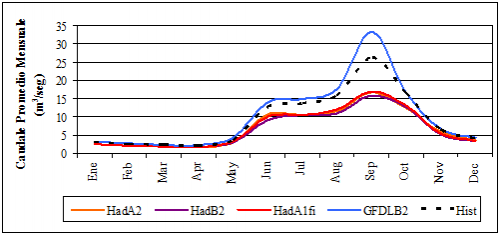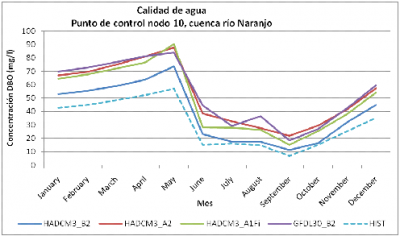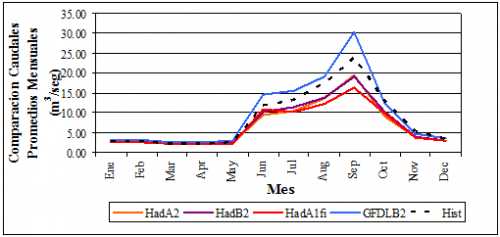Key findings from Guatemala NCAP Project
Assessing Impacts
Having developed the WEAP applications for the Rio Naranjo and Rio San Jose/Rio Shutaque catchments it was possible to assess what the impact would be on critical water factors. As an example, the simulated mid-century streamflow conditions under possible future climate conditions in the Rio Naranjo below San Marcos, of interest to stakeholders in a decision making process due to the proposed construction of an urban wastewater treatment plant, is shown in Figure 12. The simulated Biological Oxygen Demand (BOD) at the same point for the same time period is shown in Figure 13. It should be pointed out that these results were derived from a WEAP application that assumed that the population of the city of San Marcos would grow in the future at a rate which steadily declines from the current 2.4% per annum level to 0.2% per annum in 2050.

Figure 1: Simulated Mid-Century Streamflow Conditions in the Rio Naranjo below San Marcos under Different Climate Scenarios

Figure 2: Simulated Mid-Century BOD Conditions in the Rio Naranjo below San Marcos under Different Climate Scenarios
These figures provide some compelling potential insights for decision makers developing a wastewater treatment strategy for San Marcos. The first insight is that the worst case scenarios suggest a significant decrease in the flow in the Rio Naranjo relative to current conditions. This has implications in terms of the potential assimilative capacity of the Rio Naranjo as a water receiving body. Alternatively, the most optimistic scenario suggests that flows will increase. However, all scenarios agree that the increased population and the increased temperature will combine to create significantly higher BOD in the Rio Naranjo in the future relative to current conditions. This impact assessment information is of relevance to stakeholders in this decision making process.
Figure 3 provides another example of potentially relevant impact analysis. This is the simulated mid-century streamflow at the mouth of the Rio San Jose/Rio Shutaque system compared with current conditions. Recall that one current decision making processes in Guatemala pertains to whether or not water should be transferred from the Rio Shutaque watershed area to meet high water demand in the Rio San Jose watershed area. This decision certainly relies in part upon an assessment of the total aggregate water supply. It may be useful for decision makers to know that some climate projections suggest that the total yield of these watershed areas will be reduced in the coming decades.

Figure 3: Simulated Mid-Century Streamflow Conditions at the confluence of the Rio San Jose and the Rio Shutaque under Different Climate Scenarios
Next. . .
Back to:
Methodology of Guatemala NCAP Project
Netherlands Climate Assistance Programme (NCAP)
On to:
(0) Comments
There is no content